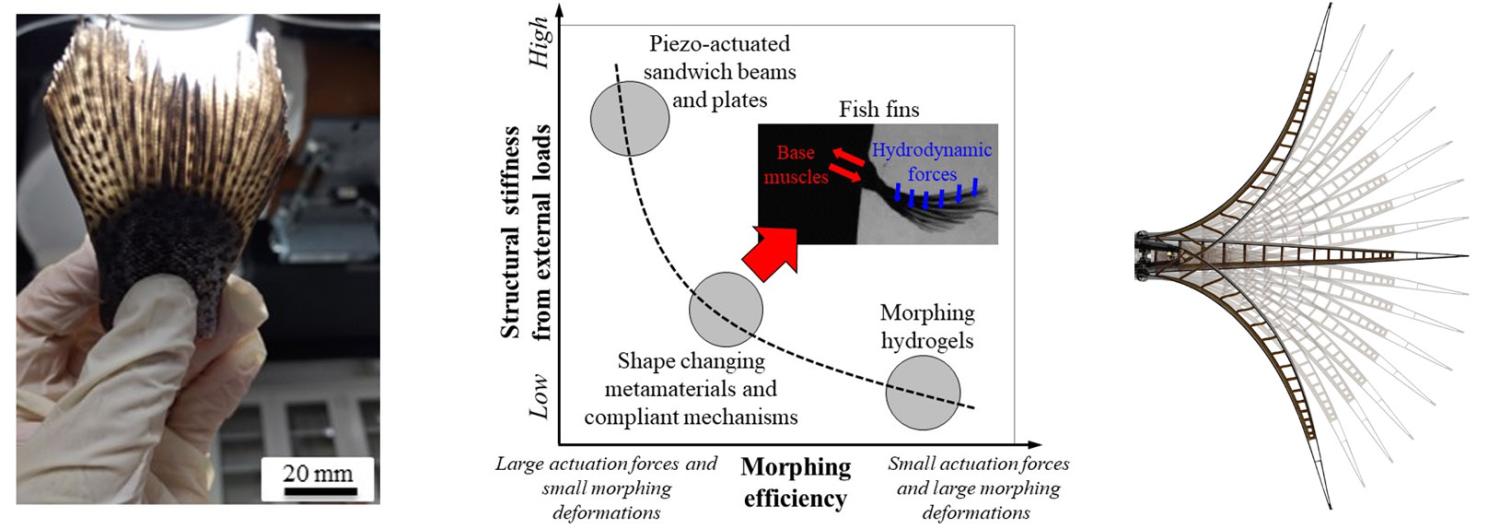Research
Laboratory for Advanced Materials & Bioinspiration
At the Laboratory for Advanced Materials & Bioinspiration we combine theoretical mechanics, numerical modeling, optimization, experimental mechanics, 3D printing and also a bit of biology (for inspiration) to explore new material designs. Focus is on inelastic deformation mechanisms, fracture toughness, energy absorption and impact, large deformations and morphing. We strive to design, fabricate and test materials with new and attractive combinations of properties such as toughness, strength, stiffness, light weight, healing, modularity, recyclability and morphing. The types of materials and structures we have been developing are broad, but they are all based on the same (bioinspired) design principles:
- Stiff, millimeter size, identical “building blocks”
- The building blocks interact via much weaker and much more deformable interfaces (or simply by frictional contact)
- Material architecture: We control the arrangement and conformation of hard and stiff phases
- We seek powerful nonlinear mechanisms: delocalization, crack tip shielding, geometric hardening, interlocking, coupling and synergies between different deformation modes
Current projects
Engineered granular crystals
In the recent past we have worked on dense topologically interlocked panels, which are made of well-ordered, stiff building blocks interacting mainly by frictional contact. Under mechanical loads, the deformation of the individual blocks is small, but they can slide and rotate collectively, generating high strength, toughness, impact resistance, and damage tolerance. In this project we expand this construction strategy to fully dense, 3D architectured materials made of space filling building blocks or “grains.” We use mechanical vibrations to assemble 3D printed rhombic dodecahedral and truncated octahedral grains into fully dense “granular crystals”. The geometry of the grain is chosen to induce specific crystalline forms: Face-centered cubic (FCC), Body-centered cubic (BCC), Hexagonal close packed (HCP), etc..These granular crystals are more than 10x stronger than traditional granular materials, and the grains can be recycled into new samples with no loss of strength. They also display a rich set of mechanisms: nonlinear deformations, crystal plasticity reminiscent of atomistic mechanisms, geometrical hardening, cross-slip, shear-induced dilatancy, microbuckling. We capture these phenomena using theoretical models and discrete element models. Once fully understood and harnessed, we envision that these mechanisms will lead to 3D architectured materials with unusual and attractive combinations of mechanical performances as well as capabilities for repair, reshaping, on-site alterations, and recycling of the building blocks. In addition, these granular crystals serve as “model materials” to explore unusual atomic scale deformation mechanisms, for example, non-Schmid plasticity.

Morphing materials and structures inspired from fish fins
State-of-the-art morphing materials are either very compliant to achieve large shape changes (flexible metamaterials, compliant mechanisms, hydrogels), or very stiff but with infinitesimal changes in shape that require large actuation forces (metallic or composite sandwich panels with piezoelectric actuation). Morphing efficiency and structural stiffness are therefore mutually exclusive properties in current engineering morphing materials, which limits the range of their applications. Interestingly Actinopterygian fishes have solved this problem. Actinopterygian fishes are named for the fin rays or “lepidotrichia" that support their fins. Fish fins “probably represent the most elaborate and refined adaptation to efficient interaction with water that has ever evolved” (Videler, 1993). The curvature and position of individual fin rays is controlled by muscles at the proximal bases of the fin rays. Individual rays are composed of a pair of articulated bony segments (hemitrichia) joined together by soft collagenous fibers that are perpendicular to the long axis of the ray. Opposing forces of the muscles at the bases of the paired hemitrichia generate shear deformation of the core and large flexural deformations over the entire ray. Meanwhile fin rays are also stiff under external transverse loads, so they can generate large 3D hydrodynamic forces or interact with hard substrates without excessive deformations or collapse.

In this project we model, design, fabricate and test ‘stiff’ morphing structures inspired from the individual rays in natural fish fins. These synthetic rays are made of stiff outer beams (‘hemitrichs’) connected with rubber ligaments which are 3–4 orders of magnitude more compliant. Combinations of experiments and models of these synthetic rays show strong nonlinear geometrical effects: the ligaments are ‘mechanically invisible’ at small deformations, but they delay buckling and improve the stability of the ray at large deformations. We also use models and experiments to explore the effects of more subtle features in natural fin rays: segmentations in the hemitrichs, structural and compositional gradients, crimped fibers. The design guidelines we develop can help the development of stiff morphing bioinspired structures for a variety of applications in aerospace, biomedicine or robotics.
Past Projects
• Mechanics of deformation and fracture of fish scales
• Biological interfaces: the intrinsic toughness of high-performance proteins
• New bioinspired strategies for toughened glasses and ceramics
• High-impact resistant materials and structures
• Design, fabrication and testing of architectured materials
• Hard yet flexible protective systems inspired from fish scales and osteoderms
• Bio-inspired bone graft materials

